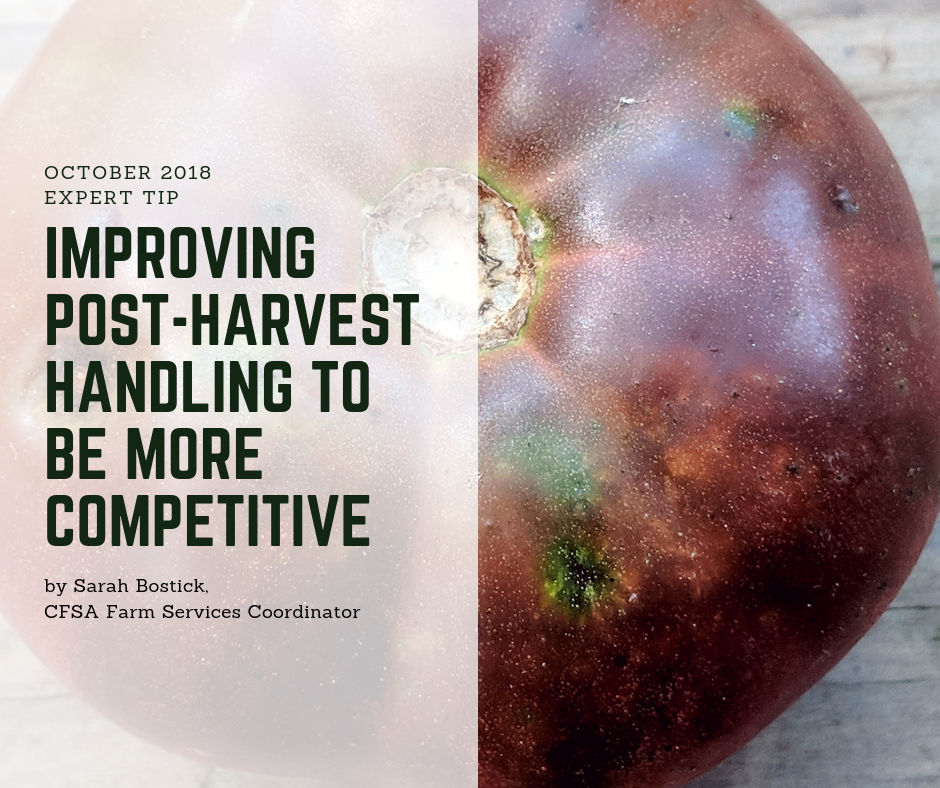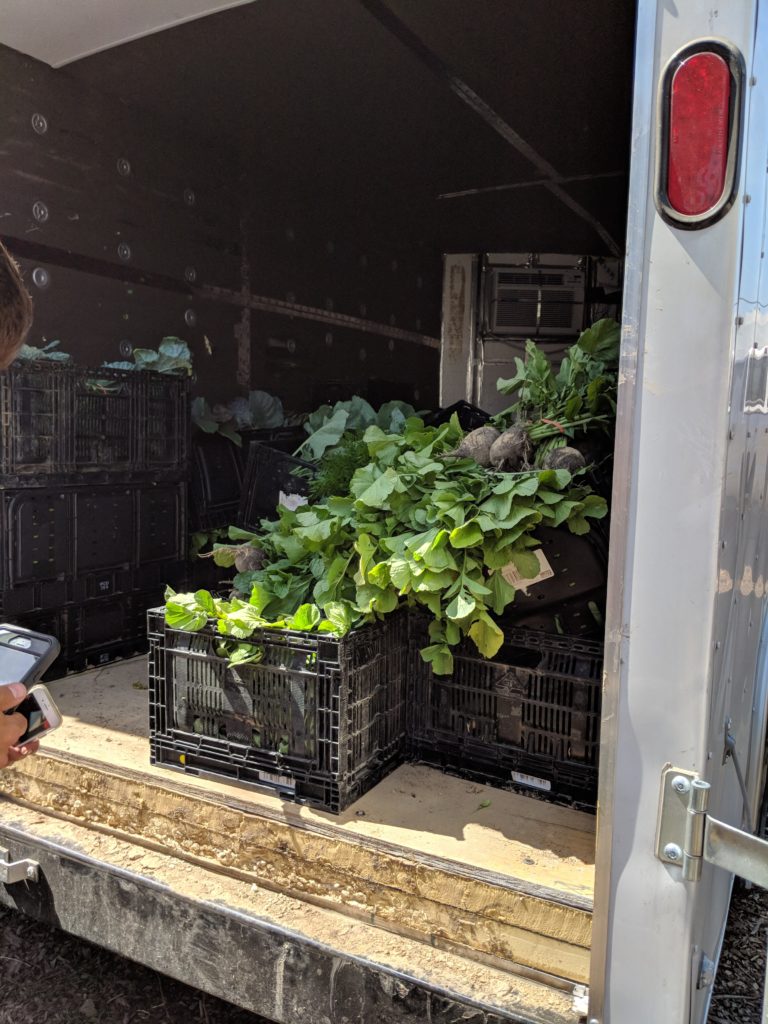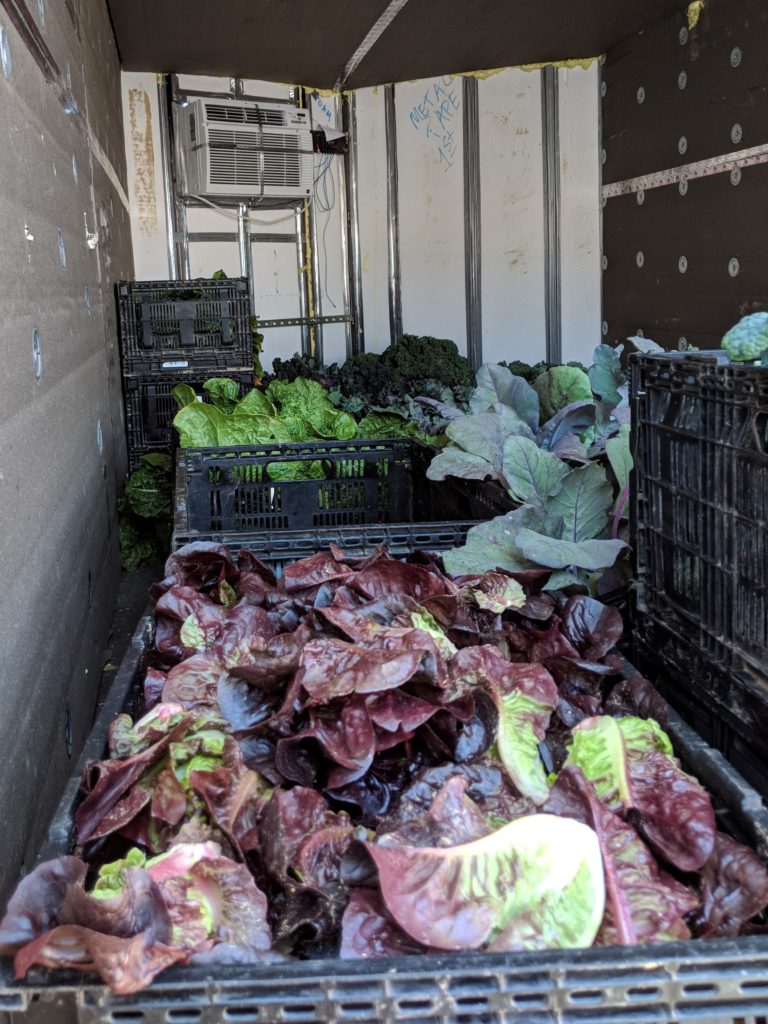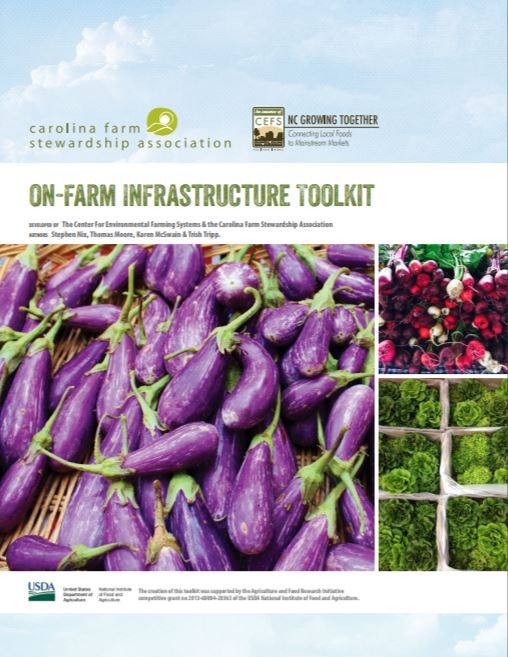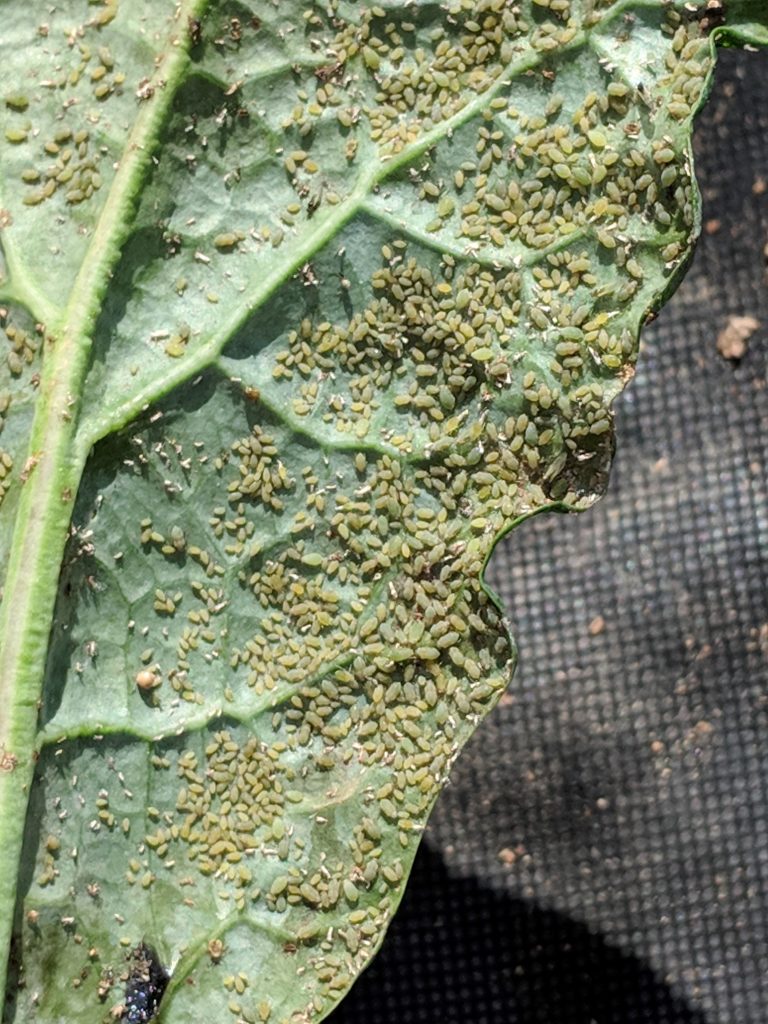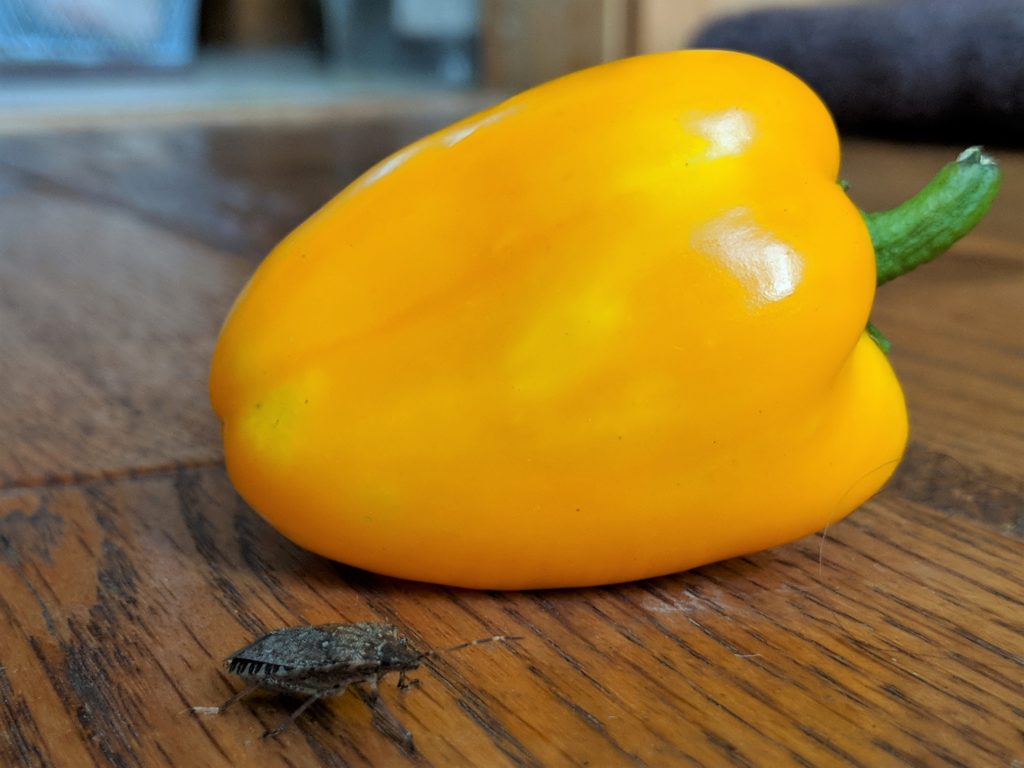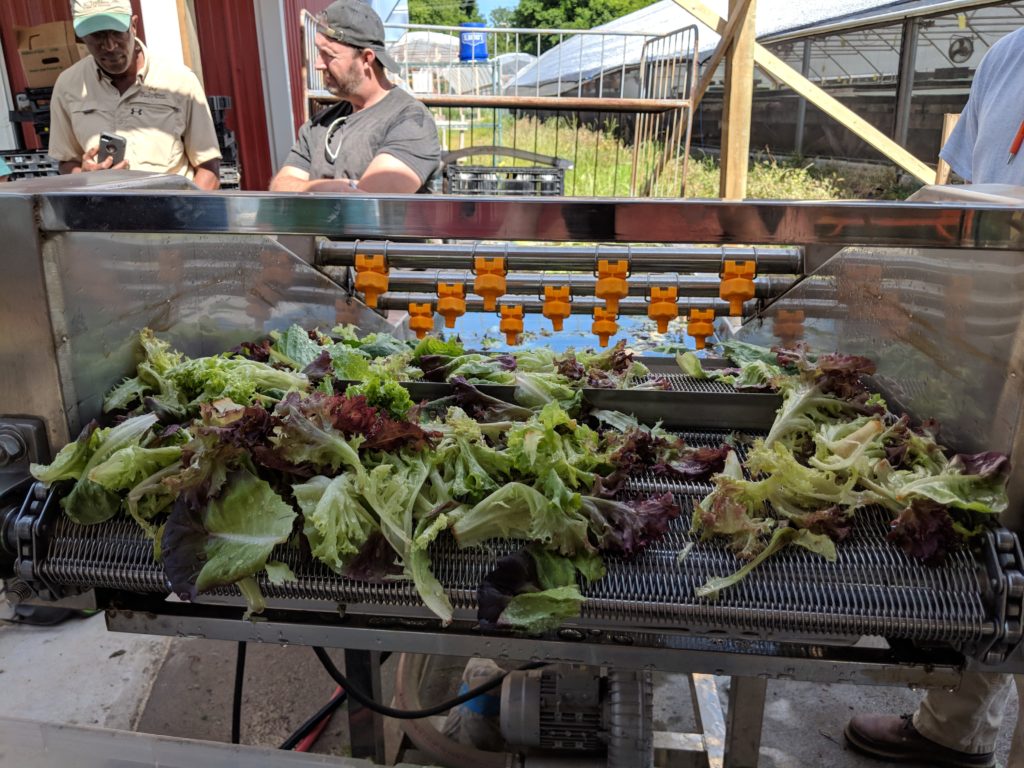By Sarah Bostick, Farm Services Coordinator | Oct. 8, 2018 –
For most of my farming career, I didn’t really think about what happened to my produce once it passed from my hands to those of my customers. I knew that it was beautiful, healthy, and something to be proud of each time I displayed it at a farmers’ market or handed it over in CSA shares. Sometimes I wondered if anyone would try that great recipe for braised fennel that I recommended or if my first delivery of husk cherries was selling at the rate I anticipated at the natural food store. But I wasn’t thinking about how well that produce was holding up once it left my hands: I assumed that it would be eaten within a few days of harvest and that it would continue to look as good the day it was eaten as the day it was picked.
I was able to see that a picture-perfect head of lettuce harvested at midday simply didn’t look good four days later, despite having been washed, put in appropriate packaging, and held in a walk-in cooler.
Six years ago, this way of thinking changed abruptly when I had the amazing opportunity to create and manage a food hub in Maine. I became the middleman, or woman as the case may be. I aggregated produce from about 15 small-scale farmers and sold it to distributors, boutique grocery stores, public school systems, colleges, and more. I would often aggregate produce from various farmers over the course of a few days before an order would be filled and ready to load into our refrigerated delivery van. For the first time in my life, I was able to see, in real time, the effects of different post-harvest handling methods on the quality and shelf life of produce. I was able to see that a picture-perfect head of lettuce harvested at midday simply didn’t look good four days later, despite having been washed, put in appropriate packaging, and held in a walk-in cooler. That a head of lettuce harvested in the cool, dewy morning still looked good four days later.
Needless to say, I wasn’t the most popular character in the lives of these farmers as I started to give feedback about the quality and shelf life of their produce. But bit by bit, we worked together to identify what was causing different types of produce to go bad faster than it should. Together we developed post-harvest handling strategies to fix the problems.
As the shelf life of our hub’s produce improved, so did our sales. One of the most satisfying moments at the food hub was the day that a farmer shared that their farmers’ market customers had noticed (and were going out of their way to tell the farmer) that their produce was holding up for days longer than they were accustomed to. One customer said that they only bought what their family could eat within a few days because the produce wouldn’t hold up much longer than that. Once this farmer changed their post-harvest handling systems to improve shelf life of their produce, their customers started buying an entire week’s worth of produce right there in that one little farmer’s stand.
Once this farmer changed their post-harvest handling systems to improve shelf life of their produce, customers started buying an entire week’s worth of produce.
So there’s the why. Let’s rewind back to our opening anecdote: We’re back with our produce. It’s beautiful. It’s fresh. We beam with pride the day it passes from our hands to our customers.
But before you make the sale, we invite you to think about: How do you keep it looking and tasting that good? And just as importantly, how long do you need to keep it looking and tasting that good?
How long do you need to keep produce looking good?
If you are a CSA or farmers’ market farmer exclusively, your customers visit you once a week, so aiming for a minimum of a week of shelf life for most produce is a great goal.
If you are selling wholesale, then that goal should be shifted to a minimum of two weeks for most crops. Why? Because that’s about how old that fresh produce might be by the time it is eaten.
Here’s an example from my years of managing a food hub:
Monday: A farmer harvests three cases of cilantro on a little farm in Maine.
Tuesday: I receive cilantro from the farmer and store it in a walk-in cooler.
Thursday: The cilantro is delivered to a distributor, where it is stored in a walk-in cooler.
Saturday: The distributor delivers the cilantro to a grocery store in Boston.
Monday: That grocery store displays the cilantro.
Wednesday: A customer purchases a bunch of cilantro.
Saturday: That customer makes tacos for dinner with cilantro harvested 13 days ago.
Freshly harvested produce pre-cooling in an insulated trailer, fitted with a cool-bot.
How to keep your produce looking and tasting good?
The number one factor in shelf life is cooling your produce down as quickly as you can. Here are two key rules of thumb:
The number one factor in shelf life is cooling your produce down as quickly as you can.
- For most produce, shelf life decreases by a day or more for every hour that passes between harvest and cooling.
- For most produce, the rate of decomposition increases by two to three times with every 18°(F) increase above ideal storage temperature.
Take a look at the ideal storage temperature, humidity, and storage life chart in Appendix D of the On-Farm Infrastructure Toolkit. Now take a moment and think through what these two rules of thumbs mean for some of your crops.
I highly encourage you to read the pre-cooling and cold-storage sections as well as Appendix A of the On-Farm Infrastructure Toolkit (see right). If you don’t already have cold storage on your farm, it will very likely benefit your business to invest in a walk-in cooler.
Air temperature before and during harvest can have a big impact on shelf life.
- If you feel hot, so does your produce!
It goes without saying that you should do as much harvesting as early in the morning as possible. It takes a lot less time to cool a head of lettuce that is harvested when the air temperature is 60 degrees than when the air temperature is 85 degrees. The longer it takes to cool your produce, the shorter its shelf life will be. - The effects of cold weather often don’t manifest until about 24 to 48 hours after a significant dip in temperature.
This is best explained with an example from my time managing the food hub. We had a big order for celery and the celery was big, beautiful, and disease-free. The night before the farmer harvested, temperatures were predicted to drop to 34 degrees, so she covered her celery beds with two layers of row cover. The forecast was wrong and the temperature dropped to 28 degrees that night. The farmer and I pulled back the row cover, determined that the celery looked totally undamaged by the frost, and carried on with the order as planned. Just 48 hours later, both the harvested celery and the celery remaining in the field showed undeniable signs of significant frost-damage.
Diseased, damaged, & insect-infested plants have a much shorter shelf life than healthy plants
Aphid infestation on Lacinato kale
Here are two common plant-health issues that affect shelf life:
- Washing away the evidence of insects doesn’t wash away the damage.
I see this most commonly with aphid infestations on brassicas. By washing aphids off of harvested brassicas, you aren’t washing away the damage that they have done to the leaves. Aphids are true bugs, an order of insect that has needle-like mouthparts that pierce through the waxy coating of a leaf and suck the liquid from the plant. Each time an aphid pierces a leaf, it is creating a tiny, open wound that opens the plant to bacteria, viruses, and fungi. This combination greatly accelerates the speed of decay in a harvested leaf. The same is true for the fruit of cucurbits infested with squash bugs and solanaceas infested with stink bugs. - Harvesting fruit from diseased tomato plants.
Disease on tomato plants is an inevitability in farming. It is also inevitable that beyond a certain threshold of disease, the shelf life of the fruit is greatly diminished. When plants are heavily infected with diseases such as bacterial spot, early blight, and Septoria, a fruit can look just fine when picked and look like something scavenged from the compost pile two days later.
Stinkbug damage on a lunchbox pepper.
Be gentle! All produce can bruise.
- Just like cold damage, bruising damage often doesn’t show up for a day or more.
Be gentle with produce and train volunteers and employees on proper handling in all steps of the process–from harvest through packing. If you can field-pack produce, do. Field packing greatly reduces the number of times that produce is handled. Bruising can’t be undone and it rapidly decreases the shelf life and quality of produce. - Make sure you are using the ideal packaging for produce.
A huge amount of research and development has gone into the creation of standardized packaging dimensions, materials, and pack sizes. There is a reason that 21 pounds of summer squash in a ½ bushel box is industry standard: It bruises easily and the combination of that box size and that weight of squash is the ideal for keeping the squash as protected as possible.
Water speeds up decay. If you don’t need to wash your produce, don’t wash it.
- Packing wet produce can create the perfect environment to accelerate the spread of existing diseases on harvested produce. There are many examples, including fungal rust on beans and Alternaria in cabbage. Take a look at Appendix B in the On-Farm Infrastructure Toolkit for a list of best cleaning options for different crops.
- If you have to harvest crops wet or wash crops that are not ideally washed, let them dry off before packing. A screen table and a box fan can be two very useful tools to accelerate drying.
And last but not least, if you are feeling ready to delve into redesigning your post-harvest handling systems and infrastructure to maximize shelf life, food safety, and efficiency, join CFSA staff for a 2.5-hour session at the 2018 Sustainable Ag Conference called The Perfect Packing Shed.
Want to learn more?
Group Learning
Meet Sarah in-person at CFSA’s Sustainable Ag Conference in Durham, N.C. on Nov. 9-11, 2018, where she’ll be teaching:
- (as mentioned above) Sarah will team up with Tay Fatke, CFSA Local Produce Safety Coordinator, to present, The Perfect Packing Shed (double session) – Saturday, 8:30 – 11:30 a.m.
- Along with Mark Dempsey, CFSA Farm Services Coordinator, and Gena Moore, CFSA Organic Research Coordinator, Sarah will present “Organic Pest Management” as a double session – Saturday, 1:30 – 4:30 p.m.
Consulting
For one-on-one help on how to implement these post-harvest techniques (and more) on your farm, see our Building Wholesale Capacity consulting services. This is free for CFSA members!
Questions?
Drop Sarah an email or give her a call at (919) 542-2402.
All photos by Sarah Bostick.



